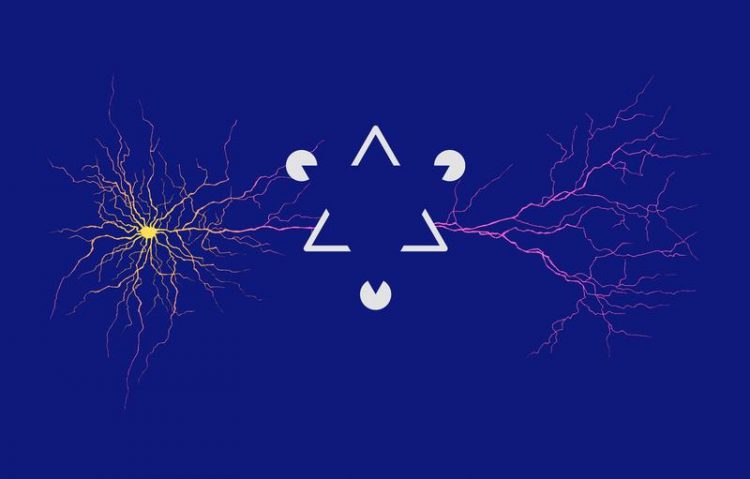Synapses in the Brain Mirror the Structure of the Visual World

Our brain is especially good at perceiving lines and contours even if they do not actually exist, such as the blue triangle in the foreground of this optical illusion. University of Basel, Biozentrum
Individual visual stimuli are not processed independently by our brain. Rather neurons exchange incoming information to form a coherent perceptual image from the myriad of visual details impinging on our eyes. How our visual perception arises from these interactions is still unclear.
This is partly due to the fact that we still know relatively little about the rules that determine which neurons in the brain are connected to each other, and what information they exchange. The research team of Prof. Sonja Hofer at the Biozentrum, University Basel studies neuronal networks in the brain. She has now investigated in the mouse model what information individual neurons in the visual cortex receive from other neurons about the wider visual field.
Neurons receive information from large parts of the visual field
The visual cortex, the largest part of the human brain, is responsible for analyzing information from the eyes and enables us to perceive the visual world. Different neurons in this brain area react to components of the visual scene at specific positions in our visual field.
Sonja Hofer and her team could show that individual neurons also receive extensive additional information from the remaining visual field. “This is not surprising, because how we perceive individual visual stimuli strongly depends on their surrounding visual environment”, Hofer explains. Individual parts of an image are, for instance, merged into lines, contours and objects.
Edges in our environment are mirrored in the brain
The new study shows that neurons are most likely to be connected if they react to edges that lie on a common axis. “Our visual environment contains many long lines and contours”, Sonja Hofer explains. “The structure of the world around us is therefore mirrored in the pattern of synapses in the brain”.
Hofer’s team believes that this specific brain connectivity might facilitate the perception of elongated lines and edges: neurons that react to different parts of such edges are connected, can increase each other’s activity and therefore boost the response that contributes to the perception of these visual features.
Our brain is so good at identifying contours and objects in images that it is sometimes deceived into seeing them even if they do not actually exist (such as the edges of the blue triangle in the foreground of the figure). Such optical illusions show how primed our brain is to detect lines and object contours”, says Hofer. “Our findings reveal a mechanism that can contribute to this skill”.
Original source
Florencia M. Iacaruso; Ioana T. Gasler; Sonja B. Hofer
Synaptic organization of visual space in primary visual cortex.
Nature (2017) | DOI:
Further information
Sonja B. Hofer, University of Basel, Biozentrum, Tel. +41 61 207 17 65, email: sonja.hofer@unibas.ch
Heike Sacher, Biozentrum, Communications, Tel. +41 61 207 14 49, email: heike.sacher@unibas.ch
https://www.unibas.ch/en/News-Events/News/Uni-Research/Synapses-in-the-Brain-Mir…
Media Contact
All latest news from the category: Life Sciences and Chemistry
Articles and reports from the Life Sciences and chemistry area deal with applied and basic research into modern biology, chemistry and human medicine.
Valuable information can be found on a range of life sciences fields including bacteriology, biochemistry, bionics, bioinformatics, biophysics, biotechnology, genetics, geobotany, human biology, marine biology, microbiology, molecular biology, cellular biology, zoology, bioinorganic chemistry, microchemistry and environmental chemistry.
Newest articles

NASA: Mystery of life’s handedness deepens
The mystery of why life uses molecules with specific orientations has deepened with a NASA-funded discovery that RNA — a key molecule thought to have potentially held the instructions for…

What are the effects of historic lithium mining on water quality?
Study reveals low levels of common contaminants but high levels of other elements in waters associated with an abandoned lithium mine. Lithium ore and mining waste from a historic lithium…

Quantum-inspired design boosts efficiency of heat-to-electricity conversion
Rice engineers take unconventional route to improving thermophotovoltaic systems. Researchers at Rice University have found a new way to improve a key element of thermophotovoltaic (TPV) systems, which convert heat…



